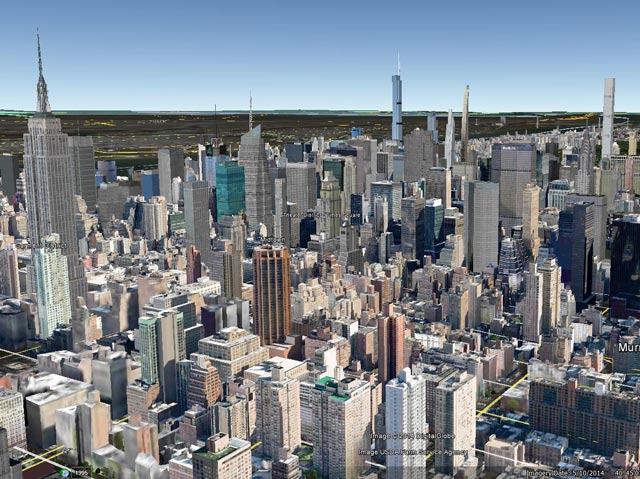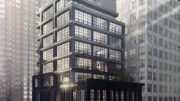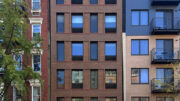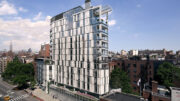New York State has arrogated New York City’s transportation system and property taxation, but it’s mostly stayed out of zoning. The one exception is a little-known provision in the State Multiple Dwellings Law, which generally forbids cities from zoning any land for residential densities beyond a floor-area ratio of twelve. And according to Mayor Bill de Blasio’s housing plan, released in May, the city intends to do something about it.
“The city,” his plan read, “will propose state legislation to remove the FAR cap and permit decisions about density to be made through the local land use process.”
Any change would have relatively little impact on citywide housing growth, since most residential construction happens in areas with far stricter zoning than the FAR limit of 12 – enough for a bulky 20-something-story building, or a much larger tower.
But upzoning areas that are already maxed out according to state law could have an outsized effect on Manhattan’s skyline. These R10 zones (and their mixed-use commercial equivalents), where any change would likely be felt, are located almost exclusively in Midtown and the Financial District, and along most of Manhattan’s avenues below 96th Street.
Right now, supertall apartment towers like those on (or soon to be on) 57th Street often reach their extreme heights by taking advantage of looser commercial zoning. They build a hotel or department store at the base, whose density is not subject to state limits. But an allowance of more residential space would make these sorts of projects more viable.
In the absence of any competing upstate interests or anything that might interfere with Governor Cuomo’s political ambitions, the state would likely agree to any request by New York City’s mayor to build more dense housing.
Another sign that the city could easily change the law is that it was originally passed with the strong support of New York City. The cap was added to the Multiple Dwellings Law in 1960, concurrent with the city’s own major zoning code revision in 1961, according to research done by Roman Pazuniak, a New York University School of Law student.
The 1961 zoning code was drawn up in a very different time. American cities were on the brink of steep decline, and density seemed to be negatively associated with good fortune. In all parts of the city – from sprawling middle-class outlying areas to crowded low-income neighborhoods, and even to the already-dense Upper East and West Sides – density was greatly restricted.
The original FAR cap was set to equal the density of the largest apartment buildings of the time, mostly on the Upper East and West Sides. Wealthier people there could be trusted with these high building densities, one zoning proposal suggested, because for them “usable open space is not as acute a responsibility of the City.”
Today, the idea of overcrowding in luxury supertall towers is absurd. Family sizes are in decline, and the popular worry about these sorts of towers is underpopulation – that they’ll sit empty, without ever being visited by their foreign oligarch owners.
There are already a few old office towers on Wall Street that have been converted to residential use through some sort of exception to the law. The 1921 headquarters of the Munson Shipping Company, at 67 Wall Street, crams an absolutely massive 303,175-square foot tower into the space of about five tenements. With a gross FAR of 25, it exceeds the state limit by quite a lot.
But far from overcrowding the tiny streets of the Financial District, 67 Wall Street was one of the conversions credited for revitalizing the Financial District and turning it into a more desirable 24/7 neighborhood.
If Mayor de Blasio wins the right to upzone for even denser residential development, he would likely use it as leverage for more affordable housing. If it must be paid for in affordable housing, YIMBY would prefer the air rights rights be sold and the affordable units built somewhere cheaper than the Manhattan core.
Demanding units in the building, with all of the amenities of an ultra-luxury tower, is now in vogue, but a mixed-income tower in Tribeca or on 57th Street is just not worth the cost. The opportunity cost of an affordable apartment in a new luxury building in Manhattan is many thousands of dollars a month. The city’s shortage of housing for the poorest New Yorkers is too high for the city to forfeit larger numbers of cheaper off-site apartments in exchange for token diversity in very high-income neighborhoods.
Hudson Yards would be the most obvious place for the mayor to test any new zoning power. The cancelation of the 7 train stop at 41st Street and 10th Avenue has put office development at the northwestern edge of the rezoning area, where housing is not allowed, in jeopardy. Silverstein has already asked the city to rezone his office-zoned land on top of the nonexistent subway station for apartments, proposing a supertall residential tower at 520 West 41st Street instead.
If he’s successful – and even if he’s not – other developers are likely to follow suit. If the city could allow higher-density housing, it could afford developers more flexibility to replace office space with more lucrative apartments, which would in turn speed the build-out of Hudson Yards.
However the mayor might use the power to upzone, giving the city to allow very high density housing would be an improvement to the current situation, where there’s none allowed at all.
Talk about this topic on the YIMBY Forums
For any questions, comments, or feedback, email [email protected]
Subscribe to YIMBY’s daily e-mail
Follow YIMBYgram for real-time photo updates
Like YIMBY on Facebook
Follow YIMBY’s Twitter for the latest in YIMBYnews





